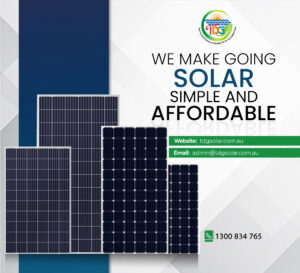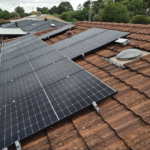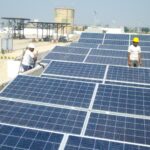Top Solar Industry Trends - COVID-19 caused a slew of unanticipated consequences that impacted both our personal and professional lives. It threw our lives into disarray, forcing us to face problems and make big changes in all areas. However, we had a fantastic year! Lockdowns, putting projects on hold, tender delays, installations, and other issues beset renewable energy industries in the same way they did establish enterprises and start-ups.

Simultaneously, the epidemic has aided the solar business in improving creativity, technology, and digitization to deploy sustainable and cost-effective energy solutions. Many firms have been able to integrate more energy-efficient equipment into their business infrastructures thanks to utility management software. According to industry analysts, the solar sector has seen ups and downs like any other industry, but it has managed to earn significant market share to this day.
Table of Contents
Global Trends That Will Shape The Solar Industry Over The Next 12 Months:
Let's take a look at some global solar trends that will shape the solar industry in the future year to get a sense of what to expect in 2021.
Availability
Every year, solar panels, wind turbines, and other renewable energy gadgets become increasingly affordable and accessible to the private sector. In their homes and even apartments, people install a variety of green energy equipment (for example, external blinds with built-in solar panels). Households can create enough energy to meet their requirements, with any excess sold back to the grid.
Typically, the government will encourage such green efforts by lowering taxes or partially subsidizing the costs of renewable energy gadgets. These programs vary from one country to the next, and even within the same country, from one region to the next.
Artificial Intelligence (AI)
Solar Power Systems for homes and companies will be heavily digitized in 2021, starting with production and infrastructure and ending with end-user gadgets. Inspections and audits are required in the solar system sector to maintain safety requirements and generate power; this requires a significant amount of human labor and time. Robots and drones may be able to assist as a result of digitalization.
Artificial intelligence and microgrid controllers can also help machine learning fulfill the expanding needs of the solar energy sector. Advanced tools, such as artificial intelligence and machine learning, could aid in the design of solar energy enterprises by identifying trends in energy demand and production.
Blockchain
The electrical market is being transformed by blockchain technology. You may deploy energy-producing assets to specific places of demand with this technique. It can also be used to create a hierarchy of priorities, allowing renewable energy certification processes to be streamlined and automated.
Power Purchase Agreements (PPAs) based on renewable assets will require certification that the energy supplied is entirely renewable. The blockchain also ensures transaction security and transparency.
Energy transactions can be recorded using Blockchain under smart contracts, lowering solar panel prices and boosting privacy.
Grid Parity is a Term Used to Describe Whether a Grid is
When the cost of alternative energy falls below or equals the cost of power from the grid, grid parity occurs.
Green energy will soon approach the pricing level of electricity providers as renewable energy becomes cheaper. Renewable energy may soon become even more economical than traditional energy sources like coal and gas, which emit tonnes of carbon dioxide (CO2) each year and contribute to global warming.
Solar Panels With Never-Before-Seen Efficiency
Solar panels, like any other technology, undergo a small increase in inefficiency every year. In most modules, the average panel conversion efficiency has increased from 15% to well over 20% this year. The payback period has been lowered to less than 1.5 years, thanks to efficiency ratings of more than 20%.
The good news is that, in recent years, not only has efficiency improved but so has the power rating. The most recent efficiency boost allowed typical 60-cell panels to go from 250 to 370 watts. As with most solar energy advancements, we should soon see even higher power output ratings as efficiency increases.
Climate Change is a Reality
Environmental threads are no longer personal problems, as we have witnessed in recent years. The climatic factor has influenced the government elections in 2020. People throughout the world are concerned about global climate change and want their governments to take steps to prevent natural disasters caused by it.
Solar Installations May Become Increasingly Difficult
Homeowners and business owners now have even more features and configuration possibilities thanks to developments in solar technology. If electrical contractors don't know what they're doing, they're in for a bigger hassle.
Here are Some of the Predicted Solar Power Trends
The Capacity of Solar Electricity on the Planet Will Grow
Solar power is the most dependable and cleanest form of energy, and its use will only grow as countries strive to achieve climate change targets. This is facilitated even more by the fact that solar energy production is simple to execute and less expensive than most other energy technologies.
Solar Energy Will be Used by More Businesses
Solar power's advantages are beginning to be recognized by businesses. It's less expensive to install, run, and maintain, as well as more cost-effective. Lower utility bills help companies control costs for a healthier bottom line, and there's also the intangible benefit of customers preferring companies that they believe are environmentally conscious.
There Will be More Work Opportunities
According to the International Renewable Energy Agency, solar energy employs 9.8 million people worldwide. The demand for installation experts, technicians, and other solar power professionals will grow as the implementation grows. A labor shortage would be a huge issue, thus there will be incentives and measures to encourage people to pursue solar employment.
Energy Storage Will Become More Competitive
The solar energy that isn't used must be stored. To boost production, the countries mentioned previously, as well as Poland and Germany, are investing in energy storage technology. There may also be a moment when governments sell solar energy that has been stored.



